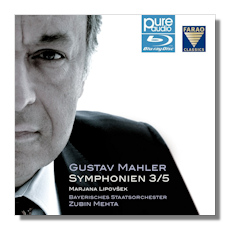
The Internet's Premier Classical Music Source
Related Links
- Mahler Reviews
- Latest Reviews
- More Reviews
-
By Composer
-
Collections
DVD & Blu-ray
Books
Concert Reviews
Articles/Interviews
Software
Audio
Search Amazon
Recommended Links
Site News
 Blu-ray Review
Blu-ray Review
Gustav Mahler

- Symphony #3 in D minor *
- Symphony #5
* Marjana Lipovsek, alto solo
* Christian Böld, posthorn
* Vienna Boys' Choir, Women's Chorus of the Vienna Singverein
Bavarian State Orchestra/Zubin Mehta
Recorded Live at the Great Hall of the Vienna Musikverein, September 16, 2004 (Symphony #3) & Bavarian State Opera, December 15, 2008 (Symphony #5)
Farao Classics Blu-ray Audio A108087 2:52:07 PCM Stereo DTS-HD Master Audio
Symphony #3 also available on 2SACDs S108047: Amazon - UK - Germany - Canada - France - Japan - ArkivMusic - JPC
Symphony #5 also available on SACD S108052: Amazon - UK - Germany - Canada - France - Japan - ArkivMusic - JPC
Both of these live performances have been issued before on Farao Classics, but separately and on SACD. Thus, this audio-only Blu-ray is their first appearance in this format and as a set. The audiences present on the day of the concerts were mostly quiet, though there is an occasional cough. With nearly three hours of music here, performed by a first-rate German orchestra and led by a conducting icon, it is obviously a release of some importance. But, I hear you ask, is it worth your attention and investment considering the plentiful competition?
In terms of length the Third is the biggest of Mahler's nine symphonies (or ten symphonies, if you throw in his incomplete Tenth – or eleven, if you include Das Lied von der Erde, which is really a symphony in disguise). The Third also seems to take the most time of any of his symphonies to get going. Indeed, it gets off to a decidedly slow start, with a lot of trombone writing that isn't particularly catchy but does, I suppose, accurately suggest primal sounds of earth, which was the composer's intention. Zubin Mehta makes about the best case possible for the opening in this performance, imparting an epic character to the proceedings with a mixture of both muscle and elegance in his shaping of the score. The march sequences are colorfully rendered and the sense that this movement rambles on or is disjointed is less evident in this performance than in many others. Mehta employs moderate tempos here and throughout the symphony, and always manages to impart a spirited sense to the music. The first movement is practically a symphony on its own and Mehta delivers its colorful world with interpretive acumen, drawing fine playing from the Bavarian State Orchestra.
The second movement is appropriately relaxed and exudes both a nonchalance and charm in its easy-going manner. Mehta gets a good sense of contrast in the faster sections. The third movement Scherzando is lively and joyous and features a lovely post horn solo in the middle section. The ensuing panel features absolutely enchanting singing by Marjana Lipovsek, making this dreamy slow movement sound utterly arresting. The women's and boys' choirs in the next movement sing with spirit and great beauty, and the huge final movement unfolds with all the mysterious and glorious atmosphere needed to build toward the cathartic climax. The orchestra plays with great precision and commitment in the process to crown this performance with a sense of both triumph and epiphany. A great effort, especially considering its live origins and the fact that it was derived from a single concert, not two or three spliced together. The sound reproduction is excellent, quite competitive with the better efforts today.
As noted in the heading the Fifth Symphony was recorded four years later and in a different venue, but there is no significant difference in sound reproduction. This is a somewhat less driven take on the Mahler Fifth, with excellent playing that often comes across as suave and confident. Again, tempos are moderate, but at times, as in the Adagietto, they tend to tilt slightly toward the leisurely side. The first movement is dark enough and quite muscular, but the stormy character and sense of desperation in the second movement are less apparent here, though the playing and phrasing are still quite convincing. The long Scherzo has the right mixture of joy and elegance, but may lack a bit of grit in the faster music. Though the Adagietto is a bit relaxed in pacing, it is quite lovely in this performance and splendidly played. The finale is perhaps a bit lighter than is customary, but has an infectious charm and great sense of joy and triumph. By the way, Mehta does very well here and throughout the symphony in drawing out and deftly applying a huge range of dynamics from the orchestra. Again, this is an excellent performance considering its live origins.
There are many great recordings of these two symphonies in the catalog by Bernstein, Chailly, Abbado, Sinopoli, Horenstein (in #3) and Mehta himself. There are dozens more beyond these actually, and so the competition is fierce. But to answer the question I raised at the end of the first paragraph regarding whether this release is worth purchase… Mehta offers splendidly conceived and well played performances that may not topple the very best available but will eminently compete with most of the better ones. In addition, Farao offers a Blu-ray disc here with excellent sound reproduction and with 21 tracks for #3 and 5 tracks for #5. Well worth your while, especially if you're interested in the Blu-ray format.
Copyright © 2015, Robert Cummings




















